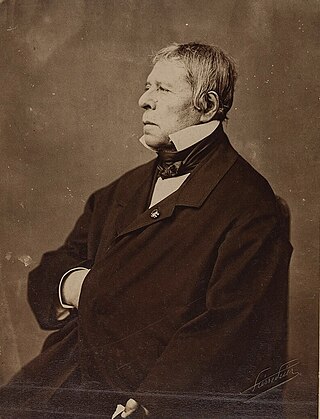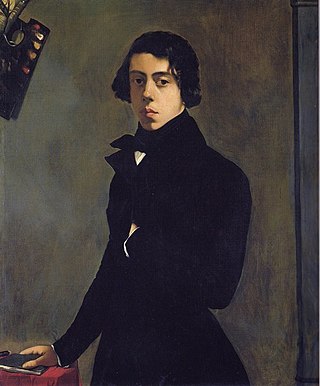
Jean-Auguste-Dominique Ingres was a French Neoclassical painter. Ingres was profoundly influenced by past artistic traditions and aspired to become the guardian of academic orthodoxy against the ascendant Romantic style. Although he considered himself a painter of history in the tradition of Nicolas Poussin and Jacques-Louis David, it is his portraits, both painted and drawn, that are recognized as his greatest legacy. His expressive distortions of form and space made him an important precursor of modern art, influencing Picasso, Matisse and other modernists.

Ferdinand Victor Eugène Delacroix was a French Romantic artist regarded from the outset of his career as the leader of the French Romantic school.

Hyacinth or Hyacinthus is a deified hero and a lover of Apollo in Greek mythology. His cult at Amyclae southwest of Sparta dates from the Mycenaean era. The hero is mythically linked to local cults and identified with Apollo. In the Classical period, a temenos, or sanctuary, grew up around what was alleged to be his burial mound, which was located at the feet of a statue of Apollo.

Anne-Louis Girodet de Roussy-Trioson, also known as Anne-Louis Girodet-Trioson or simply Girodet, was a French painter and pupil of Jacques-Louis David, who participated in the early Romantic movement by including elements of eroticism in his paintings. Girodet is remembered for his precise and clear style and for his paintings of members of the Napoleonic family.

Pierre-Narcisse, baron Guérin was a French painter born in Paris.

Antoine-Jean Gros was a French painter of historical subjects. He was granted the title of Baron Gros in 1824.

Théodore Chassériau was a Dominican-born French Romantic painter noted for his portraits, historical and religious paintings, allegorical murals, and Orientalist images inspired by his travels to Algeria. Early in his career he painted in a Neoclassical style close to that of his teacher Jean-Auguste-Dominique Ingres, but in his later works he was strongly influenced by the Romantic style of Eugène Delacroix. He was a prolific draftsman, and made a suite of prints to illustrate Shakespeare's Othello. The portrait he painted at the age of 15 of Prosper Marilhat makes Chassériau the youngest painter exhibited at the Louvre museum.

Jean Broc (1771–1850) was a French neoclassical painter. His most famous work, The Death of Hyacinthos, was completed and exhibited at the Salon in 1801.

Richard Parkes Bonington was an English Romantic landscape painter, who moved to France at the age of 14 and can also be considered as a French artist, and an intermediary bringing aspects of English style to France. Becoming, after his early death, one of the most influential British artists of his time, the facility of his style was inspired by the old masters, yet was entirely modern in its application. His landscapes were mostly of coastal scenes, with a low horizon and large sky, showing a brilliant handling of light and atmosphere. He also painted small historical cabinet paintings in a freely-handled version of the troubadour style.

Nicolas-André Monsiau was a French history painter and a refined draughtsman who turned to book illustration to supplement his income when the French Revolution disrupted patronage. His Poussiniste drawing style and coloring marked his conservative art in the age of Neoclassicism.

The Musée national Eugène Delacroix, also known as the Musée Delacroix, is an art museum dedicated to painter Eugène Delacroix (1798–1863) and located in the 6th arrondissement at 6, rue de Furstenberg, Paris, France. It is open daily except Tuesday; an admission fee is charged.

The Barque of Dante, also Dante and Virgil in Hell, is the first major painting by the French artist Eugène Delacroix, and is a work signalling the shift in the character of narrative painting, from Neo-Classicism towards Romanticism. The painting loosely depicts events narrated in canto eight of Dante's Inferno; a leaden, smoky mist and the blazing City of the Dead form the backdrop against which the poet Dante fearfully endures his crossing of the River Styx. As his barque ploughs through waters heaving with tormented souls, Dante is steadied by Virgil, the learned poet of Classical antiquity.

The Apotheosis of Homer is a grand 1827 painting by the French Neoclassical artist Jean-Auguste-Dominique Ingres, now exhibited at the Louvre as INV 5417. The symmetrical composition depicts Homer being crowned by a winged figure personifying Victory or the Universe. Forty-four additional figures pay homage to the poet in a kind of classical confession of faith.

Scenes from the Massacre at Chios is the second major oil painting by the French artist Eugène Delacroix. The work is more than four meters tall, and shows some of the horror of the wartime destruction visited on the Island of Chios in the Chios massacre. A frieze-like display of suffering characters, military might, ornate and colourful costumes, terror, disease and death is shown in front of a scene of widespread desolation.

Pierre Bouillon (1776–1831) was a French painter and engraver. Born at Thiviers, he studied with the Académie-trained history painter Nicolas-André Monsiau. He was awarded the grand prize of the Institut de France in July 1797 for his painting The Death of Cato of Utica. He exhibited in the Salon in 1796, 1799, 1801, 1804, 1819, 1822, and 1824.

Louis Antoine Léon Riesener was a French Romantic painter.

Mademoiselle Rose is a painting by French Romantic artist Eugène Delacroix, regarded as the leader of the French Romantic school. This nude was painted before 1824, and is currently held and exhibited at the Louvre in Paris. Another is at the Alte Nationalgalerie in Berlin.

The Murder of the Bishop of Liège is an 1828 or 1829 oil on canvas painting by Eugène Delacroix, showing the murder of Louis de Bourbon, Bishop of Liège by William I de La Marck's men during the 15th-century Wars of Liège, as told in chapter 22 of Walter Scott's historical novel Quentin Durward. First exhibited at the Paris Salon of 1831, it is now in the Louvre in Paris.

Cromwell with the Coffin of Charles I is a partially-varnished c. 1831 watercolour by Eugène Delacroix, now in the Département des Arts graphiques of the Louvre in Paris.

Homage to Delacroix is an 1864 painting by Henri Fantin-Latour painted in homage to the French Romantic painter Eugène Delacroix who died the year before. The work features a group of painters and writers, all of whom went on to become notable themselves, gathered around a portrait of the late Delacroix. The painting was exhibited in the Paris Salon of 1864. Today the painting is part of the permanent collection of the Musee d'Orsay in Paris.




















